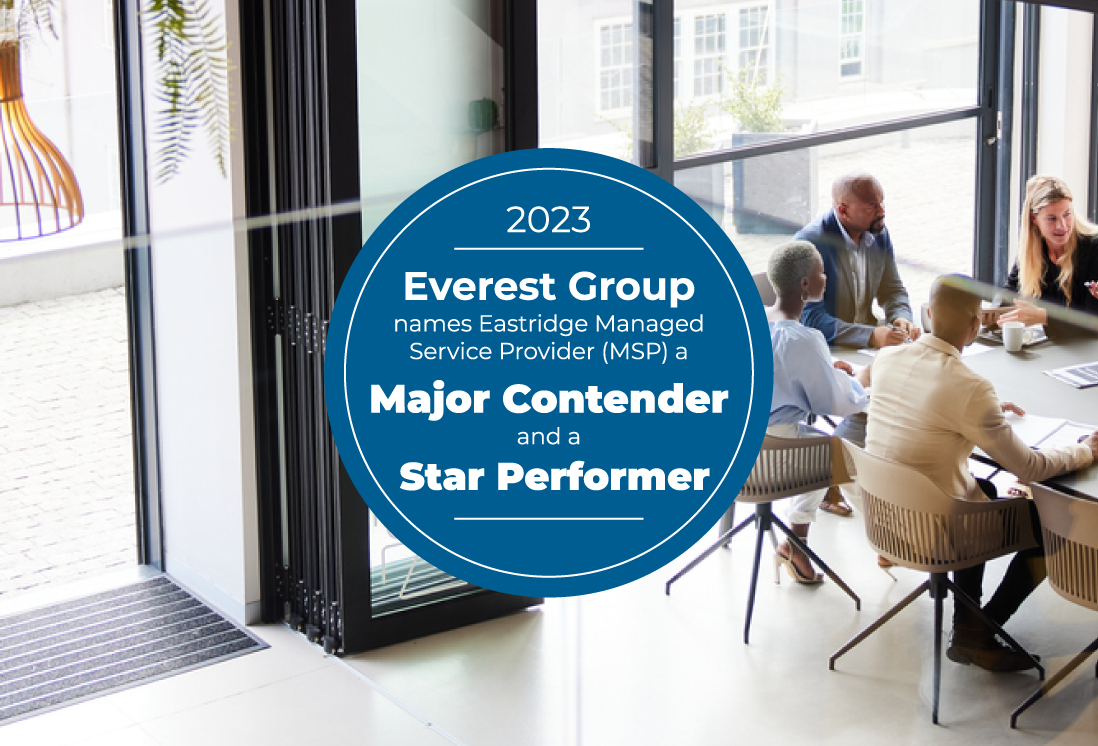What is MSP Staffing?
Contingent labor MSP programs are an outsourced solution managed by an external partner. These types of MSPs function as a component of an organization’s talent strategy by allowing companies to consolidate all contingent labor suppliers and resulting worker spend under one program. Using a Vendor Management System (VMS) such as Talient, the managed service program offers higher visibility into contingent workers at your organization.
Eastridge has divested its Workforce Management and Workforce Technology Divisions to Workwell, a global leader in human capital management (HCM) and Employer of Record (EOR) services. This acquisition encompasses Eastridge’s Payrolling/EOR, MSP, and Talient VMS business lines. Learn more
Everest Group names Eastridge Managed Service Provider (MSP) a Major Contender and a Star Performer
We’re proud to be recognized by Everest Group as both a Major Contender and a Star Performer in its Contingent Workforce Management (CWM) / Managed Service Provider (MSP) PEAK Matrix® Assessment 2023.

What are the benefits of MSP staffing?
A Managed Service Provider (MSP) in staffing gives employers a better way to manage their contingent workforce from requisition through invoicing and payment. It allows employers to realize the benefits of using a contingent workforce but, at the same time, creating visibility into spend, mitigating risk, driving compliance, increasing quality, consolidating billing, controlling spend and delivering savings, to name a few.
Staffing MSPs consolidate all staffing agencies into one streamlined MSP program, usually with one single service provider managing the entire program including staffing suppliers. All key employment data including requisition, timekeeping, payrolling, compliance, key employee performance information as well as offboarding information is all centrally stored within a single system of record, usually a VMS. This system of record provides transparency into the entire contingent workforce, which greatly simplifies workforce management.
An MSP will facilitate all employee administrative and managerial tasks such as requisition processing, recruiting, onboarding, offboarding, reporting, market insights, supplier performance and more. Working within an organization, an MSP can serve as a valuable resource to efficiently plan, build, and maintain an effective contingent labor strategy. An MSP is also essential to ensuring transparency and compliance with increasing labor reporting requirements affecting companies with dispersed workforces.

Case History
Simplifying Workforce Management with MSP Staffing
Learn how one medical device manufacturer doubled its contingent workforce while improving candidate quality, minimizing costs, and enhancing compliance. Eastridge’s MSP program helped the company to attract higher performing employees , streamlined reporting and billing, cost savings of over $200k and improved staffing vendor and compliance management.
Read MoreIs an MSP right for my organization?
There is no set company size or headcount that would make an MSP right for your organization. Generally speaking, any company that utilizes contingent labor or temporary workers from multiple staffing vendors across one or more work locations will likely benefit from an MSP.
Here are some key questions to ask to make the decision to explore an MSP:
- Are we controlling cost and risk with our current program?
- Do we currently have a robust process to evaluate staffing partners?
- Do we currently have a process to enforce spend policies?
- Have we implemented VMS technologies that give us a wide range of data on spend and usage of contingent labor?
If your current contingent program is missing all or some of these points, examining an MSP is an important first step to increase efficiency within your organization.
What are some key points to look for in selecting a contingent labor MSP?
A contingent labor MSP needs to fit the unique needs of your organization, so customization is essential. In addition, MSP providers need to be transparent with staffing sources -- whether it be through another vendor or their own staffing arm, if they have one. Not all MSPs are vendor-agnostic, so this is an important point to bring up at the outset. MSPs should also streamline management; not make it more complex. You can read more about what to look for in selecting an MSP: Eight Keys to Meeting Today's Workforce Challenges with an MSP
How does an MSP work?
An MSP greatly simplifies the management of a contingent workforce by consolidating all temporary staff, independent contractors, freelancers, and employer of record or payrolled employees into being managed and employed by one single service provider.
A staffing MSP oversees all employer functions for its contingent workforce including requisition processing, supply chain management, transactional reporting, analytics and market insights. MSPs are continually adding to their services and solutions, increasingly helping clients with resource planning to optimize how they leverage their contingent workforce.
In a staffing MSP, many clients prefer service providers that are supplier-neutral, who only manage the contingent workforce they employ and do not source the talent themselves, or prefer that they be transparent about where and how they source their talent. This is Eastridge’s approach to MSP programs.
What does an MSP cost?
There are two main pricing models for staffing MSPs: supplier-funded and client-funded. In a supplier-funded approach, a certain percentage of the amount billed by a supplier is used for program costs, which means the client pays no direct costs.
In a client-funded program, the client pays either a fixed or a variable fee directly to the MSP provider.
There are hybrid pricing models that can be a combination of supplier and client funded. It is important that the model aligns with the client’s culture, objectives and overall type of program.
What is VMS in Staffing?
A Vendor Management System (VMS) is software that facilitates communication between all parties involved with workforce management including recruiters, vendors, the MSP, and clients. With a VMS, transactions related to recruiting like candidate submission, interview scheduling, offers, billing, timecards and more happen through Talient.
A contingent workforce is a dynamic ecosystem and they require visibility and standardized processes to ensure continued cost savings, enhanced efficiency and increased productivity.
Managing your contingent workforce in a centralized, transparent system is essential. Otherwise, when different hiring managers and stakeholders use different vendors to source their talent with different processes, services, and price points, the result is chaos. Operating under a disjointed model will affect not only your bottom line but also company morale. This kind of mismanagement can also lead to weakened supplier relationships and missed opportunities for top talent.
What is the Role of a VMS in Staffing?
A VMS in staffing allows the MSP team to communicate and share data between clients and selected staffing agencies. It’s important to note that a VMS may belong to the MSP provider, but also may be separate. Although Eastridge maintains our own VMS, we also partner with VMS only providers to ensure we offer the best solution to best fit our client’s needs. VMS technology can automate and streamline the processes that support the sourcing, acquisition, management, and payment of your contingent workforce, including requisitions, approvals, time management and scheduling, expense management, payments, and real-time reporting. A solid VMS platform should also include the following features:
- Easy-to-use
- Mobile friendly
- Enterprise integration
- Data-as-a-service
- Data protection
- Global capabilities
With real-time reporting capabilities and visibility, your VMS technology can produce cost savings and empower your organization to make data-driven decisions for today and the future. To learn more about new-generation VMS platforms like Talient, schedule a demo today.
What are the Benefits of Combined MSP/VMS Providers?
Working with a combined MSP/VMS provider offers several advantages. First, a program can be truly customized to fit your organization's needs. That flexibility can carry forward to be adaptable as the program evolves over time. Another advantage is in cost. While many VMS systems are aimed at very large organizations, a tailored MSP/VMS solution can be adapted to fit the needs of virtually any organization.
Combining MSP and VMS means combining expertise with technology. An expert with all the hiring industry knowledge and technology related to the hiring industry can make your life easier. They can use the data and metrics to make constant improvements in the talent acquisition process.
What is a Statement of Work (SOW)?
A Statement of Work (SOW) is a different way to leverage talent from a third party. The primary difference from traditional staff augmentation, is most SOWs are billed based on a fixed price or deliverable without regard to a worker’s hourly wage.
A Statement of Work outlines key expectations, activities, deliverables, timelines and payments for the work that is to be performed. SOWs are not legal contracts, but are used to ensure that workers fully understand the expectations of employers. Outsourcing SOWs as part of an MSP offers the benefit of streamlining the process, ensures consistency and gives you better control over the efficiency of contingent labor.

